SPORTS Women’s hockey continues an undefeated streak, beating Maine 5–2.


SPORTS Women’s hockey continues an undefeated streak, beating Maine 5–2.

Boston College reported nine rape offenses in 2020, according to the University’s Annual Campus Security and Fire Safety Report on Sept. 30, marking a decrease from the 23 reported offenses in 2019 and 19 reported offenses in 2018.


The change in reported rape offenses could be a result of the COVID-19 pandemic, said Melinda Stoops, associate vice president for student health and wellness and student affairs Title IX coordinator.
“We have fewer people on cam-
pus, and with COVID measures, fewer gatherings or cases where we might see some activities that sexual violence may be more likely to occur,” Stoops said. “So our numbers were down and I think that makes sense given the context of the year.”
The Clery report also listed 13 reports of fondling, one report of arson, and five reports of burglary. There were another 45 disciplinary referrals for drug law violations and 646 referrals for liquor law violations—both marking a sizable decrease from the previous year.
See A2
Boston College’s theatre department puts on a production of Oil, addressing issues in the fossil fuel industry.
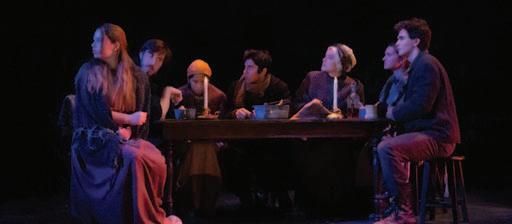
A6
See A9


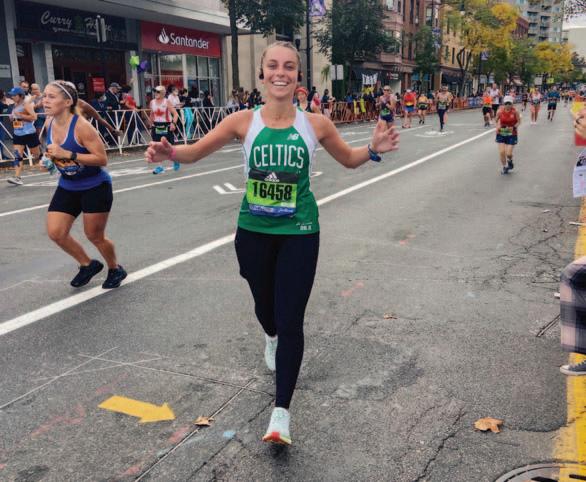
Half Ice, half wood, 100 percent fun. Head to Conte Forum on Tuesday night at 7 p.m. for a free pep rally to kick off the hockey and basketball seasons. There will be giveaways, contests, and you might even win a two-year lease of a 2022 Honda HR-V Sport.
The Clery Act, a consumer protection law passed in 1990, requires all universities that receive federal funding to publish statistics of the occurrences of 15 crimes, ranging from violent crimes and alcohol violations to Title IX violations, according to the Clery Center.
The University report is important not only for federal compliance, but also for transparency, Stoops said.
“It educates people in our community,” she said. “It also educates people coming to our community. So, whether it’s prospective students or parents or neighbors, it really puts data out there, with regards to crime statistics, so that people are informed.”
Disciplinary referrals for liquor law violations fell by 236 offenses in 2020, and referrals for drug law violations by 53 offenses.
There was also one motor vehicle theft in 2020, according to the report.
There were no instances of hate crimes, robberies, aggravated assaults, statutory rape, or incest reported in 2020.
Additionally, there were no occurances of manslaughter or murder.
The offenses in the report in -

clude those that are reported to campus security authorities and occur on campus, at non-campus properties, and at public properties, the report said.

Stoops said the offenses collected in the report mostly occur on campus, though, since the Clery Act has strict criteria for what qualifies as a non-campus offense.
Of the nine rape offenses, six occured in on-campus housing facilities.
The 13 reported offenses of fondling in 2020 marked an increase from the seven reported offenses in 2019 and 21 in 2018.
Eleven of the fondling occurrences happened in on-campus housing.
To help prevent situations of sexual violence, especially in residence halls, Stoops suggested that students look out for one another, especially at parties and gatherings.
“So, if you’re with a friend and you feel like maybe they’ve had too much to drink, bring them home,” Stoops said. “If you’re hosting a gathering just [be] responsible, again, for looking around and making sure people seem okay.”
The University also reported three domestic violence offenses, five dating violence offenses, and five stalking offenses in 2020, according to the report.
Stoops said institutional fears, like fear of punishment, can cause
underreporting.
Also, she said, students might have personal reasons to not report.
Twenty-eight percent of the most serious offenses of sexual misconduct at universities go unreported, according to a 2015 study published by the Association of American Universities.
“So, for some people, they may really feel that at that point in time that the thought of having to describe to someone what happened or to tell someone what happened may feel very overwhelming,” Stoops said.
Aside from reporting statistics, the report also outlined the University’s Campus Sexual Violence Response and Prevention Program.
“Sexual violence or sexual misconduct of any kind is antithetical to the mission of Boston College and the values it espouses and will be responded to accordingly,” the report writes. “The University strives to eliminate sexual misconduct on campus, prevent its occurrence, and address its effects.”
The University encourages students and employees to report sex offenses to the BC Police Department and the Office of Student Conduct, as well as reaching out to the Sexual Assault Network and the SANet Care Team.
Stoops said students experiencing dating or domestic violence can also reach out to University
Counseling Services, or a care team available within the Women’s Center, among other resources.
“We have a care team that’s housed in the Women’s Center, and they are available to work with anyone who has experienced sexual violence,” Stoops said. “They are designed to really serve as an advocate for the student in terms of helping them get resources, helping them sort of navigate a situation but also provide some short-term support and guidance around coping strategies.”
To combat sexual violence on the institutional levels, Stoops hopes to continue early training for first-year
students about topics like sexual violence and alcohol use, as the two can be interrelated, she said.
“I think the more we can do about reinforcing responsible alcohol use in students goes a long way in lots of different things including sexual violence,” Stoops said.
If you or anyone you know has experienced sexual assault or sexual violence, you can reach out to BCPD at 617-552-4444, the Sexual Assault Network at 617-552-2211, the SANet Care Team at 617-552-8099, and the Office of Student Conduct at 617552-3470.
 BY JULIA LANDWEHR Heights Staff
BY JULIA LANDWEHR Heights Staff
For the first time in the school’s history, Boston College was invited to attend COP26, a two-week United Nations conference on climate change. A group of BC students and faculty will join 20,000 people from around the world in Glasgow, Scotland for the conference.
The team, organized by BC Law professor David Wirth, has been granted observer status, which is given to a number of top research universities around the world.

“This meeting, in my mind, it’s like a hinge in history,” said Philip Landrigan, director of BC’s Global Observatory on Pollution and Health, who helped organize BC’s delegation. “This is the moment where humans could make those decisions that will slow climate change and preserve the
Earth for future generations. Or, it could be a missed opportunity.”
The BC delegation will be able to watch some negotiations between delegates from hundreds of countries around the world and participate in environmental presentations and events on global warming.
“This COP26 is an incredibly important meeting,” Landrigan said.
“This is where the leaders of almost all the countries of the world are going to come together and basically put on the table their commitments for what actions their counties are going to undertake to meet their obligations under the Paris Climate Accord.”
At COP26—the 26th annual Conference of the Parties—countries will make plans to slow the Earth’s warming so global temperatures don’t rise to more than 1.5 degrees celsius above pre-industrial levels, a threshold they all agreed upon with
the 2015 Paris Climate Agreement. That degree of warming, however, is rapidly approaching, Landrigan said.
“If we succumb to greed and self-interest and short-term thinking and just continue to proceed along the same reckless path that we’re going today, then we’re basically going to burn the planet up—well, not burn it up, but heat it to the point where the very survival of modern societies is threatened,” Landrigan said.
Due to the gravity of the meeting, it serves as both an opportunity to boost the school’s global standing and provide faculty and students with a slew of new connections and ideas, said David Deese, a BC political science professor who’s leading the University’s team during the second week of the conference.
“Having the BC flag at this COP in Glasgow is pretty cool because it will really lift Boston College’s reputation more generally across the major research universities,” Deese said.
“We’re also excited because it feeds into a number of initiatives for units and courses and teaching generally at BC.”
Faculty who attend the conference will have an opportunity to present what they learned to their colleagues when they return to BC as part of a faculty climate research seminar series, Deese said. He’s also excited to use material from COP26 when he teaches climate negotiation in his classes.
Undergraduate environmental
studies students with relevant research interests were also given the chance to apply to attend COP26.
Landrigan believes it will be a transformative experience for these students.
“Students have a whole lifetime of professional accomplishment ahead of them,” Landrigan said. “Seeing what can be done in an international negotiation like this I think is going to change their perspective on how they—some at least—spend the rest of their lives.”
The two-week conference will run from Oct. 31 to Nov. 12, and BC will split its attendees into two groups.
Tara Pisani-Gareau, director of the BC Environmental Studies program, and Kurt Straif, co-director of the Global Observatory on Pollution and Health, will be leading during the first week, and Deese will lead the second.
The goal is to learn as much as possible, make connections, and bring that information back to the University. Deese, Landrigan, and others involved in the planning process have been meeting weekly to read up on the latest climate science, figure out logistics like lodging, visas, and funding, and determine a schedule so that BC can cover as much ground as possible at the conference.
The plan is for the groups to split up and attend different events, and then reconvene for a lunch break and for dinner to share notes and information. The BC delegation is also planning on sending back a daily blog
from COP26, Landrigan said.
Because the UN only informed BC that it could attend COP26 about a month ago, Landrigan said, the planning has been challenging. They consulted Harvard and Tufts, both of which have attended COP summits in the past, to learn some tips about what to expect and how best to organize groups.
“We had to put this thing together from scratch in about six or eight weeks,” Landrigan said. “And I’m very proud of the job we’ve done—we’ve got a good team, we’ve got strong leaders. It’s all going to work out, but it took some pretty fast scrambling to put it together.”
With one COP under BC’s belt, Deese hopes that groups who observe the conference in the future will have a fuller experience. This year’s planning committee wasn’t able to secure any outside funding from donors or foundations to bring a big group on such short notice, but it’s grateful that BC has agreed to foot the bill, Deese said. Despite the hiccups and rushed planning, Deese is excited that BC is stepping up, and that students and faculty will hopefully be able to attend this conference for years to come.
“We won’t have an official role in the actual conference, whereas for the next COP, which will be located in an African country about a year from now, we expect to have a role on the agenda and present some of our research, and have a larger, kind of more official, BC presence,” Deese said.
Editor’s note: This story contains the mention of suicide, a topic that ma y be disturbing to some readers.
If you or someone you know is in crisis, contact Boston College’s University Counseling Services at 617-552-3310 or the National Suicide Prevention Lifeline at 1-800-273-8255.
Craig Burns, director of University Counseling Services ( UCS) at Boston College, said there has been a noticeable increase in students seeking help t hrough UCS this academic year.
“This year, as would have been predicted, [there are] certainly more students coming in,” Burns said. “It was a built-up demand.”
Universities and colleges across the country have been facing a student mental health crisis in t he wake of the COVID-19 pandemic, which sent college students home from their campuses in the spring of 2020.
Man y of these students did not return to campus, instead taking classes virtually, and those who did return faced a college life tainted by COVID-19.
College students have since shown increased levels of anxiety and isolation, and, according to the Centers for Disease Control
and Prevention, about a quarter of young adults considered suic ide during the pandemic months.
The University of North Carolina at Chapel Hill canceled c lasses on Oct. 12 to give its students a “Wellness Day” after two suicides and an attempted suicide that occurred in residence halls the weekend prior.
O ver the last decade, there has been a large population of people seeking out mental health care, particularly in reporting themselves at a high level of crisis, according to Burns.
The trends over the previous decade have … [shown] the increasing presentation of particular anxiety,” Burns said. “There ar e definitely more people seeking services … and particularly s eeking crisis services.”
UCS hopes to confront this issue by opening up more accessible services to BC students t o further address their needs, he said.
“We made some changes in the way we deliver service a couple of years ago … to open up more rapid access,” Burns said.
After students were sent home from campus in March 2020, telehealth services became a common way in which people received help, Burns said.

Since then, UCS worked to expand to new services that it
believed would support students to a greater degree.
“Last year … we had more drop-in-style support groups, as a way for people to access us when they were just needing support, rather than when they were at that really elevated level,” he said.
This year, UCS is continuing to provide hybrid services for individuals.
“We’ve had pretty close to 50/50 selections by students on whether to schedule those appointments in person or by telehealth,” Burns said.
People are becoming increasingly comfortable with addressing the mental health issues they ar e experiencing than in years past, according to the American Psychological Association.
A big priority for UCS has been addressing that growing need.
“People are more familiar with the idea of engaging with treatment, and also more comfortable,” Burns said. “There’s l ess stigma attached to that. What we are trying to do this year is again maintain that availability in the face of growing demand s.”
Ainsley Kohler, the head of communications and PR at BC’s chapter of Lean on Me, a national confidential peer-to-peer text line, said that Lean on Me hopes
to fill the gap between the services UCS is able to provide and t he support that students need.
“We exist to fill a gap that UCS can never really fill,” Kohler, MCAS ’23, said. “There are so many students on campus. As an independent student group we have more control over what we expose our supporters to versus admin, [which] I’m sure is a m uch slower process.”
Lean on Me plans to work with a much broader range of students to meet their needs this year.
One way it hopes to do so is through partnerships with student organizations.
“ We’re really excited to hopefully continue … peer support wor kshops with different organizations on campus,” Kohler said. “H aving the opportunity to
go into all sorts of student orgs, not just mental health–related, and just sit down and talk with students about what it means to be a supporter to the people around you.”
Burns said he appreciates that student organizations are able to provide additional support to students who are struggling with their mental health.
“Over the last few years, I have really appreciated seeing the growth in student engagement around mental health t hrough a number of different groups and interests, whether that’s through Lean on Me or ot her groups,” Burns said.
“That’s the level that helps make a big difference when students can connect with peers without the stigma and with a sense of acceptance and support.”
Under tent canopies and hanging strings of light, vats of sweet, spic y, and soul-feeding cultural dishes lined O’Neill Quad after nightfall on Thursday.
But for students who hoped to reach the inviting aromas, there was a catch, according to Raquel Guevarra, co-president of the Philippine Society of Boston College (P SBC).
“In order to get food, you’d have to play a game and win a ticket,” Guevarra, MCAS ’22, said.
That was the premise of “Night Market,” an after-dark event hosted by the Southeast Asian Student A ssociation, Asian Caucus, and the Organization of Latin American Affairs at Boston College.

Ten clubs showcased their respective cultures through food, traditions, and games in the spirit of night markets, which bring people together in cities across the globe.
At the Cuban-American Student Association (CASA) table, a few students were huddled around a game of dominoes, which is popular in Cuba, Paul Alderete, CASA v ice president and MCAS ’22, said.

“[There are] a lot of people here, I mean, it’s awesome,” Alderete said. “We’ve got people walking by, stopping, grabbing food quickly.”
Maybe too quickly, he said, as CASA’s aluminum foil pan full of plantains had already run out within the first hour of the event.
Deloshene Sittambalam, co-president of the South Asian Student Association and MCAS
’22, said that the plantains were “really good.”
She, too, enjoyed the atmosphere at Night Market.
“It’s a lot of great energy,’’ Sittambalam said. “I think people are r eally excited to be back in person and just to have a lot of face time and in-person time with friends and other clubs.”
Sittambalam said that after the event was canceled last year due to the COVID-19 pandemic, she is happy to be able to host the event in person this year.
“We’ve had it for the past few years,” she said. “I had it my freshman and sophomore year as well. … It’s good to see this back and running again.”
The main goal of the market is to bring people together through food, Sittambalam said.
“Food really brings people together, especially cultural food,” she said. “Especially international students coming to the states and getting to have a taste of cultural food is awesome for them.”
In the Philippines, food markets serve as places where people go to have fun after a hard day or to be with others, Guevarra said.
“You can see it pretty much like on every island and it’s usually just something that people go to after work or just have fun with their families and it’s pretty common out there,” she said.
At the PSBC tent, passersby had to be on full alert, unless they wanted to leave with a shoe print
on their face.
“So we served longganisa which is a Filipino sausage with rice and eggs,” Guevarra said. “And then our game tonight was basically, knock down the cans with a sandal.”
At the Chinese Students Association (CSA) table, students raced against each other moving marbles from one bowl to another with chopsticks.
After that, they could grab a bite of tanghulu, according to Maggie Rong, CSA co-president and MCAS ’22.
“[Tanghulu’s] like taking multiple types of fruit and putting me lted sugar on top of it and then it’ll harden when you take it out,” Rong said. “It’s a sugar shell on the outside and the fruit inside.”
After a year of virtual events, interacting with other culture clubs
at events like Night Market brings the CSA closer to other members of the BC community, Rong said.
“I think one focus that CSA has this year is engaging with more [people of color] and also engaging more with the BC community as a whole,” she said.
And at a loud outdoor event like Night Market, all BC students are exposed to what culture clubs have to offer, Rong said.
That might not be the case at a usual club meeting held behind closed doors, she said.
“Hopefully [students passing by] do engage with us, like try some of our food, play our games,” Rong said. “But even if they don’t, I hope that they see that our community is really strong, our community is really welcoming, and they don’t feel afraid.”
Maria Scibelli Greenberg is seeking re-election for her third term as Ward 1 councilor. After her election in 2017, Greenberg said her top priority has been constituent services.
“As your Ward 1 city councilor
my community and have a proven record of being an effective advocate for my community.”
Greenberg has focused on engaging in community-building efforts for her constituents.
She encourages groups, such as Newton Corner Neighborhood Association and Jackson Homestead Neighborhood Association, to collaborate and tackle issues together,
residents of Nonantum, a village in Ward 1, are being heard. Greenberg worked with NNA to implement an Italian American Heritage Day in 2022, according to her website.
Along with Nonantum, Greenberg supports local businesses across all the villages so they can maintain their liveliness and vibrancy, according to her website.
She has worked with the tree warden to plant more trees in Ward 1 and improve the tree canopy in an effort to combat climate change and beautify the community.
Greenberg supports affordable, accessible, and diverse housing while on the council.
1999, where she raised her family and sent her four children to Newton Public Schools.
As a Ward 1 councilor, she currently serves on the Programs and Services, Land Use, Real Property Reuse, and Special Re-Precincting Committees.
Greenberg did not respond to The Heights’ request for comment.
Running for ward councilor in the ward in which he grew up, Kevin Riffe is hoping to keep Ward 1’s traditions and values alive.
cast as a senior director, where he worked for the past 38 years. He previously volunteered at the John M. Barry Boys and Girls Club of Newton’s youth programs and served on its board of directors for over five years.
The priorities he lists on his website include public safety, education, and parks and recreation.
If elected, Riffe seeks to create a safe environment for all Newton residents by emphasizing public safety.
I am your liaison and advocate at city hall,” Greenberg said in her campaign video. “I take my job as your representative seriously, and I will do what I can to help you. I love
By Josie McNeill Asst. Metro Editor and Shruthi Sriam For The Heights Ward Councilor James CotePreviously councilor-at-large from 2014 to 2020, James Cote is running for Ward Councilor in Ward 3.

“I’m really excited to have the opportunity to campaign around Ward 3 to see firsthand all aspects of your daily life,” Cote said in a campaign video.
Cote, a former marine, said he plans to use his experience as a former councilor-at-large and member of the Finance, Public Safety & Transportation, and Land Use committees to assist him in the position of city councilor.
He wants to focus his work on how to get Newton back on its feet after the devastations of COVID-19. He emphasized the lack of experience of the other councilors in their first terms.
“There have been gaps or issues to resolve,” Cote said in the video. ‘West Newton in particular was challenged by events, and the worst possible time of governance. Given that our ward, with two new city councilors, had the least experienced councilors of the eight wards. We can fix this.”
Cote said he also wants to focus on projects that promote the happiness and well-being of residents, such as upgrading parks. He said he fought to obtain private funding for West Newton Common and Wellington Park as a councilor.
According to his website, his leadership in combatting the Opioid Crisis led to the establishment of the Mayor’s commission on opioids and influenced the use of Narcan, a medicine used for opioid overdoses, by first responders. He also worked on the first assisted living facility that Newton has seen in many years.
she said on her website.
She has also worked with the Nonantum Neighborhood Association (NNA) for the past 10 years to ensure that the voices of the
Cote did not respond to The Heights’ requests for an interview.
Julia Malakie, a long-time resident of Newton, is seeking re-election as Ward 3 councilor.
“I’m an almost lifelong-resident of West Newton, now serving my first term on the City Council,” Malakie said in a statement on her website. “I’m very grateful to the residents of Ward 3 for electing me in 2019 and giving me the opportunity to serve you.”
Malakie said she faced unexpected struggles in her first term as councilor, citing the pandemic, the racial justice movement sparked by the murder of George Floyd, and the recent attempted opening of a gun store in Newton.
She will continue to work on these issues, and the issues that stem from them in her next term, Malakie said.
Malakie prides herself on her community outreach and bipartisanship as a city councilor, according to her website.
“Ward 3 is no exception in having diverse views, and I won’t pretend that I can please all people all the time on every issue,” Malakie said. “But as a ward councilor, I am also the person many people look to when they need help with a problem, whether it’s a leaking sewer, parking problems, neglected properties, construction noise, property damage, or just finding information.”
Malakie did not respond to The Heights’ requests for an interview.
Pamela Wright is running for re-election as councilor-at-large. As the only engineer on the current council, Wright said this background and training gives her a unique perspective on the council.
“I am trained as an engineer,” Wright said. “I use facts and data to
Through collaboration with developers and residents, she has ensured that housing is the right fit for the neighborhood, she said on her website.
Greenberg has lived in Newton since 1992 and in Nonantum since
figure out problems, I look at the fine details and their implications, I listen to the residents, and that makes me, I think, somewhat unique.”
Wright speaks about the unique analytical thinking engineers are taught to employ. She said that this thinking brings a diversity of thought to the council.
“You want diversity in a group, with people who are younger, older, different religions, different backgrounds, different colors of people, different financial levels, all sorts, and that makes the group better,” Wright said.
Wright also has experience volunteering in Newton schools. She worked as the tournament director for the FIRST LEGO League Eastern MA championship, coach for a high school robotics team, and as an educator for the Child Assault Prevention program.
Housing and rezoning issues were a big push in Wright’s decision to run for reelection, Wright said. The long-term implications of the lack of affordable housing in the city need to be spoken about and addressed, Wright said.
“I originally ran because I felt that we were going down because of the zoning redesign, which could really affect Newton for the next 50 plus years,” Wright said. “I wanted to be at the table to give a voice to some of the residents that felt like they … were not being heard.”
Wright believes the biggest issue with the council is the contentious division among the members.
“The city council is kind of divided,” Wright said. “Usually we can [work as a team], but sometimes things can become really contentious, and there’s name calling.”.
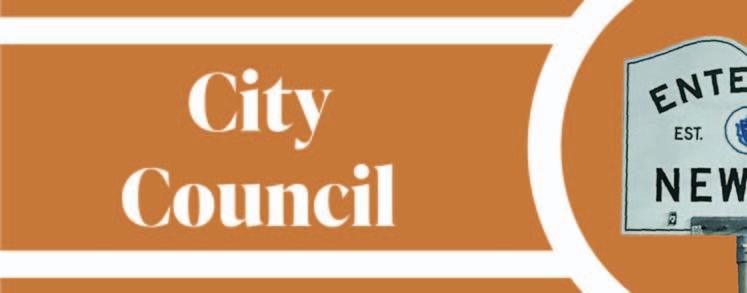
Andrea Kelley is running for her third term as councilor-at-large and has been highly involved in the community, raising her family in the city.
“I have a passion for the traditions and the people who made our ward great,” reads Riffe’s website. “I will work hard to maintain those traditions and values and work for the members of our community through availability, transparency and follow through and I humbly ask for your vote on November 2nd.”

He recently retired from Com-
She said her role as a council member provides her with a unique and crucial way to vote on issues she would previously only advocate for, and be a part of making change in a more impactful way.
“I felt it was really important at this point in time, to be able to vote on these issues rather than just speak up about them,” Kelley said.
Kelley has experience in advocacy and volunteering work, including serving as Newton’s first Open Space coordinator, past president and current member of the League of Women voters, and Local Action co-chair of PTO council.
Through her past volunteer experiences, Kelley said she spoke on behalf of large groups of people. In order to do
“I believe that we owe it to the residents of Ward 1 and the rest of the city to provide a safe environment for everyone in the city,” he said on his website. “We should be working with our police officers, firefighters, and other first responders, to rethink, reimagine, and strengthen how we do this important work.”
Riffe did not respond to The Heights’ request for comment.
and serving within the community, specifically with the League of Women voters, as well as in her experience working with advocates on Beacon Hill, giving her a range of legislative experience. These experiences have given her skills within policy making, but also in working with a diverse range of communities, she said.
“For one thing, I know our community very well,” Kessler said. “I’ve volunteered in a number of different capacities. I know people throughout the city. We have lots of different interests. And I think, first and foremost, knowing the community and knowing the people at the community, is a great advantage to moving into the political realm.”
Meryl has four main priorities in
this successfully and tactfully, she said she had to take time to absorb the full range of facts she was being presented with before speaking out for them.
“I was even then just very aware of things—I couldn’t just speak for myself, I had to be sure that I was reflecting the goals and mission of the organization,” Kelley said. “That has been very helpful for me now as a city councilor, to understand that need to be more patient and circumspect.”
Meryl Kessler’s primary goal on the council is to make Newton a place for people to live with their families, as she moved her family to Newton 26 years ago.
Kessler has experience volunteering
this election, including recovery and rebuilding from the pandemic, fiscal health and transparency, community building, and looking toward a sustainable future.

To work toward recovery and rebuilding, Kessler wants to repair infrastructure and create more affordable housing options for a large portion of the city’s residents.
“I think we should take a good look at our city’s social services and infrastructures, to figure out how to better support our vulnerable residents going forward,” Kessler said.
Kessler also said her major goal, if elected, is to continue maintaining a close relationship with the residents of Newton.
One of the best parts of serving on the Newton City Council for incumbent and fifth-generation Newtonian William Humphrey is being able to see the difference he has made in the lives of residents.
“The part of city council that I really enjoy is that I can see very tangibly the ways in which I’m helping to improve people’s lives on a day-to-day basis and make their lives easier, and that’s a very rewarding feeling,” Humphrey said.
emphasizing his constituent services work, increasing affordable housing in Newton, and working to meet the goals of the Newton Climate Action Plan.
Debra WallerDebra Waller has lived in the city’s fifth ward for 27 years. Waller said she is running for council because she cares about Newton and is concerned about the growing power of private interests in the city’s government, according to her website.
“I am running because I want to help Newton have a future that benefits everyone, not just an increasingly small and powerful financial elite,” Waller said
Incumbent Deborah Crossley hopes to continue her work toward a better and stronger Newton that she aspired for 12 years ago when she entered her first term as Ward 5’s councilor-at-large. Running for her seventh term now, Crossley said there is still much work to be done.
“There’s still work to do,” Crossley said. “I suppose you could say there’s always work to do, but when I ran 12 years ago, it was because of two broad ambitions that I had.”
These ambitions were taking better care of the city’s public spaces, such as buildings, roads, and parks, as well as more effective city planning—or what Crossley refers to as strategic planning. According to Crossley, this strategic planning includes adding more affordable housing in Newton and supporting local businesses.
Crossley’s ambitions, however, were met with the unexpected challenges posed by the COVID-19 pandemic.
Council’s work changed.
“It was really surprising how much didn’t change as far as City Council went,” Downs said. “We still met, we just met on Zoom.”
Now, as Downs runs for her third term for Ward 5 councilor-at-large, she said her platform is all about COVID-19 recovery for the city, businesses, and residents, as well as improving trust, transparency, and accountability in NPD.
But even as Downs adapts her platform to reflect the last couple of years, she said she is still committed to the daily concerns of residents such as making streets safer, increasing affordable housing, and tackling local climate issues.
grew up in many different parts of the world and said those experiences gave her a strong sense of cultural sensitivity and open mindedness, according to her website.
Getz and her husband initially moved to Newton to raise their family.
“We chose Newton because of its walkable neighborhood schools, historic village centers and abundant green open space,” her website reads.
During her children’s primary education, Getz served on the Angier School Building Committee and was co-chair of the Respect for Human Differences Committee.
Another aspect central to his tenure as councilor is his role in city hall and committee meetings. Despite the challenges posed by the COVID-19 pandemic, Humphrey said hosting city hall and committee meetings in a virtual format increased resident attendance. The pandemic also garnered more support from the city for his 2019 campaign pillar of economic justice reform, leading to new programs in Newton such as emergency rental assistance.
“The pandemic gave us an opportunity to work on economic justice issues that had been interesting to me previously, but not necessarily a major focus for the city,” Humphrey said. “So after the pandemic hit, I went around and distributed information on emergency rental assistance, which is an example of a program that we didn’t have before the pandemic, and we created it to try to help people.”
In addition to issues of economic justice, Humphrey said the main focal points of his re-election campaign are
By Julia Remick Metro Editor Ward Councilor Brenda NoelFirst elected in 2017, Brenda Noel is running for re-election with the intent to make constituents’ everyday lives better.
“It’s one of the best jobs I’ve ever had, being a city councilor, because I think it’s the ability to listen to my constituents and to be able to serve in this capacity, and the role of government is to make people’s lives better,” Noel said. “And I don’t think people realize the opportunities one has in local government to make people’s lives better. And it’s an amazing opportunity, and I just feel lucky to be in this position.”
In previous terms, Noel said she has advocated for funding so Newton’s public schools can operate safely, advocated for policy changes to expand outdoor dining, and pushed for the installation of crosswalks and safety lights to improve pedestrian and bike safety.
In addition to championing larger projects with the Newton Mayor Ruthanne Fuller and her administration, Noel also responds to constituents in a “boots on the ground” way. She makes herself available to residents through phone, email, and social media, as well as hosting monthly office hours and sending out a weekly newsletter.
“Part of my job is to be responsive to people’s concerns and infrastructure needs,” Noel said.
Last week for her neighbor who re-
on her website.
As a former engineer at the Digital Equipment Organization and vice president and director of risk analytics at the Federal Home Loan Bank of Boston, Waller said her background in data analysis gave her the skills to make reasoned decisions, according to her website.
Waller said she has three primary goals to help Newton become a “more democratic and responsible city.” These goals include supporting rezoning objectives that residents not only want but also understand, depoliticizing the Newton Police Department, and restoring integrity in the public process.
According to Waller, she is a lifelong moderate Democrat dedicated to supporting the everyday needs of Newton residents.
Waller did not respond to The Heights’ request for an interview.
“There was so much uncertainty,” Crossley said. “Not knowing was the worst part. Not knowing when we would get vaccines. Not knowing what the protocols should be. Not knowing how much money we would lose.”
Crossley also credited the city’s strong foundation in its ability to recover from the losses of the pandemic. But even as the city adjusted to this “new normal,” Crossley said she never stopped working.
When Andreae Downs entered her second term on the Newton City Council, she did not forsee Jake Auchincloss’ election to the United States Congress that would make her the new chair of the Newton Public Safety and Transportation Committee, the murder of George Floyd and the protests that would follow, nor the pandemic that would force the city council to adapt to a whole host of new challenges.
Some of the biggest accomplishments of her second term, Downs said, have been opening up the southern part of the Sudbury Aqueduct, which is now a walking trail in Newton, as well as working to make the city’s streets safer for pedestrians, bikers, and drivers alike. But Downs also expressed her excitement about work to come if re-elected for a third term.
“I’m excited about … a vision of a Newton that is strong on community, strong on climate resilience, and feeling safe for all residents,” Downs said. “That’s the sort of thing I really enjoy. I also kind of enjoy the constituent services, being able to help get some sidewalk or pothole filled or tree planted or to connect neighbors with each other around projects.”
Rena Getz
Hoping to give the residents of Newton a voice on the issues that directly impact them, long-time Newton resident and local advocate Rena Getz is running for Ward 5 councilor-at-large.
Over the last eight years, Getz has served on her local Neighborhood Area Council—she is a founding member and the current vice president of the Waban Area Council.
Getz is also a board member for The Friends of Hemlock Gorge, a local conservation organization that works to preserve the nature reservation, and was elected as a delegate to represent Ward 5 at the 2021 MassDems Platform Convention.

“I believe I am a proven community leader and resident advocate,” she said on her website. “As your City Councilor, I pledge to be your representative and support your priorities.”
According to her website, Getz is also committed to learning more about housing and zoning in Newton through her participation in the Citizens’ Housing and Planning Association and the Congress of the New Urbanism.
Getz cites former Ward 5 Councilor-at-Large Brian Yates as the initial inspiration for her civil engagement in Newton. Getz worked on Yates’ last three re-election campaigns for city council. Getz said Yates’ death motivated her to run for office to honor “his priorities and the vision he held for Newton.” Yates, BC ’71, died in 2019.
Crossley
quested a sidewalk upgrade on Walnut St., Noel said she called Commissioner McGonagle at 7:30 a.m., who then called engineering to get the issue fixed.
Barry Bergman
Barry Bergman is running for his first term on the council to protect and enhance the city of Newton.
“The primary or the what got me going is the, I guess this trend over the past 10, 20 years of modest homes being bought up by developers and being -replaced by out-of scale mansions,” Bergman said. “So we’re losing our inventory of modestly priced homes and we’re gaining an inventory of very expensive homes.”
While talking with residents, Bergman said residents are against tearing down homes that are then replaced by out-of-scale mansions. Bergman said his opponents are promoting eliminating single-family housing to allow two homes to be built on a single lot, which Bergman feels is not a pathway to affordable housing.
Another one of his motivations for running is the environment, Bergman said. He wants to see Newton improve the tree canopy and fix the city’s natural gas leaks. In front of his own house, Bergman said he does not have any grass since he decided to replace it with trees.
“We decided years ago, you know, to pull out the lawn and put in trees, so it’s not the most beautiful yard in the neighborhood, but it’s something that in the morning I feel good walking out there,”
Although Downs’ second term was full of unexpected events, she said she was surprised by how little of the City
Bergman said.
Alicia Bowman is running for her second term as councilor-at-large in Ward 6. While she said she managed to get a lot done in her first term, she said that there is still more to do.
“I am running because two years ago I ran on on a platform that I’m still working on which is addressing climate change, developing more housing options, and making our city more walkable and bikeable and [increasing] access to public transportation and reducing dependency on vehicles, because that makes for a stronger city,” Bowman said.
Transportation is where Bowman said she first got her start, ensuring that her children were able to safely walk to school. In her first term, Bowman helped to implement stop signs at dangerous intersections and advocated for the redesign of Auburndale St. and Commonwealth Ave. to include a multi-use path, upgraded pedestrian crossings, and an overall safer road design. Bowman said she looks forward to weighing in on the council’s Pedestrian and Bike Master Plan.
“In this year’s budget resolution I was successful in getting all 24 city councilors, even people who don’t always line up behind bikes, to say ‘a bike master plan makes a lot of sense, we should do it,’” Bowman said.
In her next term, Bowman said she
“My main goal is to advance the residents’ vision for Newton,” Getz said on her website. “Together we can create a sustainable future for our city while respecting our past. … My highest priority is to listen, to understand and to act on the concerns and viewpoints of Newton residents.”
Although she was born in Spain, Getz
plans to work on the inaccessibility in Newton Highlands and Newton Centre, as intersections lack an ADA accessible ramp. Bowman said she will also continue to work to improve sidewalks in the city.
Victoria Danberg
Victoria Danberg is seeking re-election for councilor-at-large in Ward 6. She was first elected in 2004 and has lived in Newton with her husband since 1997 to raise her family.
“I am running for re-election as your Councilor at Large to be able to continue to contribute to the City’s progress and to serve my neighbors as we work to make Newton the best City it can be,” Danberg said on her website.
Since her election, Danberg has
Getz did not respond to The Heights’ multiple requests for an interview.
include environment and energy conservation, public education and safety, improvement of village centers, and “adaptive reuse” of current buildings to maintain character and meet the city’s needs.
Danberg did not respond to The Heights’ request for comment.
Lisa Gordon
Lisa Gordon is running for councilor-at-large in Ward 6. Her number one priority is ensuring that all voices are heard in order to improve the city and meet the future’s challenges, according to her website.

Gordon’s top priorities include infrastructure, education, and zoning and development. Gordon said that the city’s
advocated for multiple housing options, particularly in locations near public transportation, according to her website. She has also worked to secure long-term financial planning for public buildings, schools, roads, and infrastructure; ban polystyrene products and plastic stirs; and bring green and renewable energy solutions to public buildings such as the library.
Her priorities for her next term
Capital Improvement Plans need to be updated in order to maintain the roads and sidewalks.
“Moving through Newton should be a reasonable and not a frustrating experience with well-maintained buildings, bridges, sidewalks, roadways, open spaces, and fields,” Gordon wrote on her website.
Gordon did not respond to The Heights’ request for an interview.
Lights swirled and an ominous narration boomed through the speakers in Robsham Theater Arts Center.
Images of snowfall and trees faded as the shadows of the scaffolding of oil rigs were projected on the stage.
Boston College theatre department’s production of the play Oil transported its viewers across generations as main character May (Emma Thompson, MCAS ’23) travels through time—recounting the discovery of oil and the subsequent construction of global industries centered around the fossil fuel industry.
The performance opened the department’s fall 2021 season on Thursday night and ran through Sunday.
Written by the British playwright Ella Hickson, the play initially premiered in London in 2016, and BC’s director Patricia Riggin, who is also an associate professor in BC’s theatre department, has had Oil in the back of her mind for years.
When selecting the plays she wants to produce with her students, Riggin said she searches for works written by female playwrights that also provide political and social commentary.
“I hope that [the audience] will look at the history of this, of the oil industry,” Riggin said. “I hope they will think about their dependence on oil and reflect on ‘Where is the balance?’ We can’t go on like this.”
During the rehearsal process, Hickson was able to virtually meet with Riggin and the two student script advisors, known as dramaturges, Grace Cutler, MCAS ’24, and Thompson.
Hickson offered guidance and insight into her intentions behind the evolution of the two main characters—May and her daughter
Amy.
Oil is divided into five parts, each set in a different time and location.
But, the character of May guides the audience through the plot and time travels across periods.
In part one, when a businessman, William Wittcomb (Tyler Dean, MCAS ’25), shows May an oil burning lamp that illuminates the stage, May sees the oil and the business deal with Wittcomb as an opportunity.
For the rest of the play, Thompson as May guides the audience through the development of the oil industry—what becomes the backdrop to May’s life.
In this leading role, Thompson was onstage every minute of the play, except for her quick costume changes between parts.
“I kind of feel like I’ve been living and breathing Oil for the last two months, but it’s been very, very worth it,” Thompson said.
Bringing the play to the Robsham stage has been an intense process of four-hour rehearsals for five days a week.
But, when the curtains came up the extensive hours of rehearsal paid off as the actors relished being able to perform in front of a live audience again after the COVID-19 pandemic put a stop to them last year.
“I forgot after having not been in a live setting for theatre for so long, like how much the audience does impact like the way you’re performing and the energy you have on stage,” said Abigail Wickman, who plays May’s sister-in-law and MCAS ’24.
The set design, done by Boston-based designer Cristina Todesco, smoothly guided the audience through the five settings of the play. Since the different acts of the play are set in five different locations—Cornwall, Tehran, Hampstead, Kirkuk, and Cornwell—a screen above the stage flashed with the location and the year that the
following scenes took place.
The props also reminded the audience where and when the action took place. The desirable resource that characters sought out shifted from the oil in an old-fashioned lamp to a new futuristic machine, called the toroid—the world’s new source of energy in part five, which is set in 2051.
Thought-provoking with nearly every line, the play and its actors invited the audience to consider their own complicity in the oil industry and the exploitation of people and the earth.
Part two comments on the imperialist nature of the industry as native people are manipulated for labor.
Connecting past injustices with the present, part three displays the disconnection between oil companies and the countries where they extract the resource, as May shows little concern for the people living near her company’s rig in Libya.
In part three—set in Hampstead in 1970—the play blends both the cerebral examination of the oil industry with the emotional conflict between the strong-minded mother and daughter pair.

Hickson’s feminist messages shine through as May insists that her daughter Amy (Margaret Whyte, MCAS ’25) leaves behind her clueless boyfriend Nate (Javier Gushe, MCAS ’25) to carve out her own path in the world.
The two clash as Amy criticizes her mother’s actions as an oil company executive and May reminds her daughter that she relies on products made from oil, including the gas powering her car and condoms.
“I think it’s a really good reminder that we are all culpable in climate change,” Thompson said. “To a certain extent it’s out of our control, but also we are in charge of holding the people in power accountable for everything that’s go-
ing on.”
Given the play’s address of current sustainability issues, Thompson and Cutler reached out to the environmental advocacy clubs on campus to ask if they wanted to be involved. Climate Justice at BC came to Thursday’s opening night performance to hand out flyers in the lobby, sharing its demand for BC to divest from fossil fuels.
In the final scene of the play, the actors stood in formation, filling up the entirety of the stage—their costumes representing different time periods spanning from 1889 to 2051—and the four actors who played Amy as a little girl, teenager, young woman, and middle-aged woman united.
Whyte delivered the final line that’s interrupted by the sound of a match being struck—reminding the audience, as the theater lights go down, that they are living through a period of reckoning with the oil industry.
Friday evening.
From 6 to 9 p.m., McMullen’s student visitors enjoyed the museum’s vast collection of artworks but also a variety of Halloween-themed activities, videos, live performances, and interactive displays reflective of the night’s theme—“Grotesquerie of Lights.”

Despite its name, the event was nothing short of delightful—students made their own paper lanterns, created glow-in-the-dark paintings, and played a variety of games while being serenaded by the BC Music Guild in the McMullen atrium.
Interactive projection and fog
art exhibitions cast the museum in a ghostly, ethereal light while an outdoor game of “ghost in the graveyard” was played outside the museum.
Lauren Landry, a member of the McMullen staff and MCAS ’23, explained that the Art After Dark event was intended to be a small event but generated a large turnout of BC students.
“[The event is] all about happy, positive fall vibes aimed at taking what can be a cold-feeling museum to some and making it [a] much warmer and cozier place to visit,” Landry said.
In between the event’s activities, ample apple cider, donuts, and cheese were provided by the McMullen, imbuing fall spirit.
The Music Guild drew a large crowd to the atrium with the group’s live performances.
Particular highlights were an acoustic guitar duet by Colin Martin, MCAS ’24, and Cole Dumas, MCAS ’24, of The Cure’s “Friday I’m in Love” and an impressive rendition of Vance Joy’s “Riptide” performed by Paula Toledano Cabrera, CSOM ’23.
A powerful rendition of The Animals’ “House of the Rising Sun” was performed by Bayar Tuvshinjargal, a BC grad student, and Cormac Delaney, MCAS ’25. Final-
ly, Melissa Mao, MCAS ’23, performed some of her original songs.
The museum showed several horror movies throughout the event, including The Host (2006), Oculus (2013), and the “White Bear” episode of Black Mirror
These weren’t the only videos on display, though, as one of the interactive exhibits projected abstract and classically spooky clips over the art pieces featured in the second-floor gallery.
Another interactive exhibit took the form of “fog art”—displayed by projections filtering through a dense, machine-produced fog in a tent behind the museum.
Mao said that the McMullen team was very helpful when setting up the stage and equipment for the Music Guild, and she thought the food included at the event was fantastic.
Music Guild co-vice president Elliott Shin, MCAS ’22 wanted to extend thanks to the McMullen staff for inviting the Music Guild to be a part of the event.
“We hope that our music was a good accompaniment to the art on display,” Shin said.
The Art After Dark event at the McMullen wasn’t just an exhibition of student talent, but a wholesome and fun night that, for many, embodied the joys of the fall season.


Zac Brown Band’s latest album, The Comeback, is a 15-track masterpiece that rediscovers what makes us human, celebrates the things that bring us together, and recognizes the resilience people have shown in the past year.
After its last album, The Owl (2019), was met with an underwhelming response from fans, Zac Brown Band (ZBB) returns to its country roots in The Comeback, released on Oct. 15. It touches on themes that are reminiscent of past albums—genuine love, Georgia roots, and living life to the fullest.
The previously released single “Same Boat” reminds us that although we come



from different walks of life, we are all going through the same experiences. Although a simple sentiment, the song contains a profound philosophical message.
On “The Comeback,” Zac Brown takes a more hopeful approach as he speaks of the calm after the storm, the light after darkness, and the reckoning following a wreckage.
“The only good thing about getting knocked down / Is the comeback when it comes back around,” he sings.
Brown collaborated with country music singer and songwriter Luke Combs to make “Old Love Song.”
With two of the best talents in country music coming together, it is no surprise that they were able to create pure lyrical magic, referencing classic love songs by
Bob Dylan, Al Green, Marvin Gaye, Bill Withers, and many more.
“Stubborn Pride” and “Wild Palomino” are both brilliant ballads, but “Any Day Now” is the heartfelt gem of the album. It could even be the most emotionally rich song the band has written thus far. The climax gives listeners chills as Brown sings, “No I wasn’t done loving you / So many things I meant to do / I’m cold as the pillow by your empty nightstand / You’re long gone now with my heart in your hand.”
The Comeback, is not only a comeback for the band, but, as ZBB sings on the album’s “Fun Having Fun,” it also serves as a reminder that we need to appreciate every day because there really are only so many “trips around the sun.”


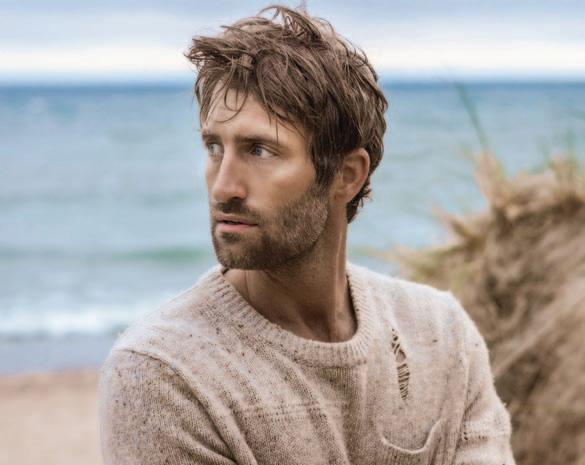 BY KIERAN WILSON Heights Staff
BY KIERAN WILSON Heights Staff
Ryan Hurd’s debut album, Pelago, has been a long time coming, although he’s no stranger to the music industry. Hurd has penned hits for other artists like Blake Shelton, Lady A, and Dierks Bentley, not to mention that his wife is pop-country superstar Maren Morris. But Hurd’s new album should turn the heads of country music fans. Pelago, which is an homage to Hurd’s Michigan roots, showcases his penchant for clever and introspective songwriting, as he delivers songs about cliched topics in refreshing ways.
“Pass It On” kicks off Pelago and finds Hurd adding his own twist to the tried and true country trope of positivity and having

a good time. With twangy guitars, backing vocals from Morris, and an easy-flowing rhythm, Hurd encourages people to pass on whatever they have to other people.
“If I Had Two Hearts” contains some of the best songwriting on the entire album. On this track, Hurd reflects on a past relationship. In the chorus, he tells his former flame what he would do if he had two hearts: “If I had one more to give you, baby, I know what I’d do / I’d let you break that one, too.” This is such a simple turn of phrase but says so much about Hurd: He is so lost and has fallen so hard for this girl that, if he had another heart to give, he would give it to her in a heartbeat.
“Chasing After You” is almost sure to be Hurd’s biggest commercial success, helped by the fact that it’s a duet with his

equally talented wife, Morris. Hurd and Morris wrestle with the complicated feelings that come with an on-again, offagain relationship. Soft electric guitars and percussion slowly build throughout the song, mimicking the song’s tangled relationship. Hurd and Morris both end the song singing the same sentiment: “You come back to the love you were running from / Don’t know why, don’t know why I let you but I do / Guess I love chasing after you.”
Pelago shows Hurd for what he is: a country music all-star who deserves more of the spotlight than he gets. It’s not as though he sings about things that no one else does, but he molds his words in such a way that his feelings come out in catchy, sincere, and clever ways.

Meek Mill’s Expensive Pain struggles to keep its best moments afloat as painfully generic lyrics and beats drag the rest of the album down.
Atlanta battle rapper Meek Mill has returned after a three-year hiatus with his fifth album Expensive Pain, released on Oct. 1. His last few years have been filled with legal issues and prison time. During that time he also joined up with Jay-Z to fight for criminal justice reform. But, Expensive Pain only touches on this part of Mill’s history briefly, never really dwelling on it. In fact, the only song that focuses on Mill’s prison time for more than an instance is “Blue Notes 2.” Instead

of laying bare the vulnerabilities that come with spending time in prison and advocating for criminal justice reform, Mill produced some of the most generic lyricism on Expensive Pain
Mill offers some fleeting moments of insight into his life. He talks about how he hates the idea of needing bulletproof glass in his cars and how he wants to raise his sons right. On the other hand, “Blue Notes 2” dives deep into ideas like being the richest man in the prison. But these ideas just aren’t fleshed out enough to save the album. They appear for an instant, and then Meek loses interest in them.
Meek’s beats also fall flat on this album. There are a few high points. “Blue Notes 2” has one of the most energetic and fun beats on the album. “Hot” catch-
es fire early on, with a mix of electronic beats and Mill’s rapid delivery of lyrics. The chorus of a medley of voices in the background of “Sharing Locations” helps save an otherwise generic song and really punctuates every lyric on the track. But, most of the beats on Expensive Pain are just forgettable.
Despite some strong moments on the album, Mill spends most of his time on Expensive Pain running with unoriginal lyrics that if pushed a little further could have made the album an intimate portrayal of Mill’s journey with the criminal justice system. After a hiatus from music since 2018, Mill could have returned to the music scene with a bang. Instead, Expensive Pain fades into the background of the rap genre.


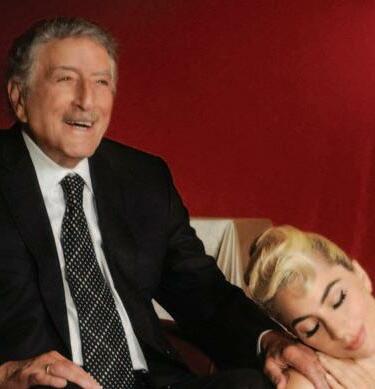 BY LAUREN JASEN Heights Staff
BY LAUREN JASEN Heights Staff
Tony Bennett and Lady Gaga pay tribute to renowned composer Cole Porter in the release of their second collaborative album Love For Sale
The veteran crooner and the contemporary pop star have a friendship that transcends time. The two first met at a New York gala in 2011, where Bennett heard her singing a rendition of Nat King Cole’s “Orange Colored Sky.” He went backstage and asked Gaga to sing a duet with him on his Duets II album. A few years later, they released an entire album together entitled Cheek to Cheek. But
Love For Sale, released on Oct. 1, is said to be the last of their collaborations, as Bennett was diagnosed with Alzheimer’s disease in 2016.
At first glance, Gaga and Bennett seem like an unlikely duo, but that is exactly what makes their partnership so special. He wears fine Italian suits. She wears dresses made of meat. He’s timeless. She’s cutting edge. But, these Italian New Yorkers separated by two generations share a chemistry that is indescribable. They complement one another like an aged chianti and a fresh cannoli. The two are a true match made in heaven.
The album is primarily composed of old Broadway hits that were performed
by some of the most prominent artists of the time—including Ella Fitzgerald, Miles Davis, Fred Astaire, and Frank Sinatra. Gaga and Bennett reinvigorate these classic tunes from a bygone era, and their playful exchange of lines throughout keeps the album refreshingly witty.
They also have solo moments throughout. Gaga’s theatrical side and jazz training shine in Fitzgerald’s “Do I Love You” and “Let’s Do It.” Bennett showcases his rich sound in Fitzgerald’s “So In Love” and “Just One Of Those Things.”
In wood sculptor Ken Packie’s world, each project is an opportunity to assume a different identity.
“I get lost in it,” Packie said. “It puts you right in the moment. If I’m carving a fox, I’ll think about the foxes I see, or I’ll look at videos for reference and [try to understand] what the animal is thinking.”
For his most recent commission, Packie challenged himself to consider the daily experiences of a more difficult subject. His latest work, a 14 feet by 7 feet statue of the Holy Family—Jesus Christ, Mary, and Joseph—overlooks Commonwealth Ave. on Boston College’s Brighton Campus.

On commutes back and forth from BC during the days he was working on his carving, Packie said he listened to podcasts about the life of Jesus and his family, answering questions like, “What was the beginning of his life like? And what was their daily life like?” Packie said that reflections on the importance of the subject matter put him into the right headspace for his craft.
After COVID-19 sent the world into quarantine in March 2020, Packie was slammed with orders and requests for his sculptures—with people spending more time at home, many decided that they needed art to spruce up their decor, he said. One such customer was BC, who contacted Packie about a potential project.
Last November, Director of Landscape Planning and Services Regina Bellavia made the difficult decision to remove a 200-year-old tree which threatened the safety of pedestrians due to the way it was rotting. University President Rev. William P. Leahy, S.J., had seen a news article about Packie’s sculpture of a marathon runner near Heartbreak Hill and recommended him for the job, Packie said.
For 15 days over the course of five weeks, Packie transformed the old, red oak tree into a lifelike rendering of the Holy Family.
Creating art from a formerly living thing is not easy, Packie said. Ants had nestled in the back of the tree, and the trunk was rotten or hollow at some spots.
At one point, he hit a rock which the tree had grown around, he said, but the sheer size of the tree still made it a worthy canvas for the sculpture.
For Packie, salvaging the remains of old trees is a way to honor nature in a world where the environment is often mistreated. Even before becoming a carver, Packie loved spending time in nature— whitewater rafting, climbing, mountain biking, and snowboarding.
He often refuses to take on jobs involving a tree that doesn’t need to be taken down, he said.
“This is a living thing,” Packie said. “It’s 100 years old or older, and it’s nice that it’s preserved. It’s got a new form.”
Packie said that sculpting a very realistic human form out of a tree trunk was his most difficult challenge to date, from the crinkles near the eyes to the details on the fingers.
According to Packie, depicting the clothing was also tricky, as the robes needed to drape off the arms and shoulders, while still maintaining the appearance that a human body exists under the heavy clothing.
prompted reflection during his work on the Holy Family.
“I started thinking about that aspect of it too,” he said. “What does this mean to people? But you know, what does it mean to me? Where do I stand with this?”
By Anna Lonnquist Magazine Editor Stephen Bradley Assoc. Magazine Editor MC Claverie Asst. Magazine EditorAccording to Packie, Leahy was very helpful with the design of the sculpture, offering suggestions on the gesture of the hands and the tilt of the head.
“Father Leahy has a wonderful eye for form,” Packie said.
ved g time in n nature mountain snowboarding n r ef us es t o ta k e olv l ing a tree that e d t o t a k en id a “It’s 100 years served. It’s rm.” aid very rean fo f rm e ost dif-f ll en ge m the ar th t e details g e rs g to cting g was as the d ed t o he arms rs, ning the e t h a t a dy exists h e av y ng to e ah y pful ign of the sculpture on the gesture of the hands f th t e head a has a wonderful ey e e for e said
Aside from the technical aspects of human form, the significance of the subject matter weighed heavily on Packie. He was baptized in the Catholic Church and attended church regularly as a child, but he said he doesn’t anymore. Still, the significance of his religious experiences
Jason Emmons, a fellow professional wood carver, was especially impressed by Packie’s finished product.
He
inally worked as a telecommunications technician. He and his family moved to the Berkshires for a new job, testing and tuning up high-speed networks. The company required him to be constantly on call, and Packie said that the lifestyle left him feeling burnt out.
In 2006, Packie attended a home show, which is a convention for home decor and furnishings, that featured a live wood sculptor. Whereas other sculptors render wood bears in a cartoonish fashion, what Packie calls “square bears,” this particular sculptor employed a very realistic style. Packie said that this lifelike bear interested him much more than the other wood-sculpted bears he had seen around New En-
“I thought that was the limitation of the tool, but it was actually the limitation of the operator,” Packie

Having never touched a chainsaw before, Packie took a class on wood sculpting and was hooked. After a year and a half of carving as an amateur, Packie attended a big gathering of carvers located in Pennsylvania.
the help of local loggers and other benefactors, Packie took the leap of faith.
“They’re all supportive of me and so much help in town,” Packie said. “I say it as a joke, but seriously, it takes a village to raise a carver.”
In the beginning, Packie was surprised by the physical aspect of wood sculpting.
“I wasn’t really concerned about the physicality of the job, but it kicked my butt,” Packie said. “Holding the chainsaw all day, and standing up logs, and bending over and picking up trunks—the hard part was my body adapting to the physical work.”
Persevering through physical strain and uncertainty, Packie’s success reminded him of an event from his adolescence.
Before senior year of high school, Packie attended a week-long career testing examination. He tested off the charts for spatial mathematics, and someone recommended architecture as a possible career, he said.
He took a drafting class, but he hated the straight lines and structure of traditional architecture. Now, Packie credits his natural skills to his aptitude for math.
“When I started carving, I had the confidence that I could see in 3D and that my mind worked the right way,” Packie said.
According to Emmons, Packie also brings a keen attention to detail and inexhaustible energy for carving.
“He brings a lot of passion to what he does,” Emmons said. “With that passion comes a lot of energy, and it’s contagious. He’s definitely the kind of guy you want to have around and be friends with.”
knocked it out of the park , and he should be getting all the praise that he’s been getting from that piece and then some.”
On Oct. 11, many Boston College students woke up earlier than usual for a Monday morning, dressed up in funky outfits, and crossed Commonwealth Ave. to party on off-campus streets. After 910 days, Marathon
Emmons travels the country with Packie as part of the Bear Hollow Wood Carvers, and has known him for around 15 years, all throughout Packie’s remarkable entry into carving, he said.
Emmons travels the country w ith
Sizing himself up against professional carvers, Packie says he realized that he could make a living on wood sculpting. He set up outside a local country store near his home in the Berkshires and quickly became swamped with enough orders to leave his old job in telecommunications.
Packie says that the BC staff and grounds crew were incredibly helpful for his work. University carpenters built Packie a platform to stand on, and people stopped by to bring him water on hot days.
“I felt like I was a rock star up there, and that made my life so easy,” Packie said.
Packie’s journey to wood sculpting resulted from a rather unexpected career change. Born in New Jersey, Packie orig-
Monday had returned.
Some BC students, though, woke up with a different agenda—to begin a 26.2-mile run.

After over a year-and-a-half without a Boston Marathon due to


He said his family encouraged him to make the uncertain change, even if it meant cutting back on vacations and Packie needing to work every day. With
Next up on Packie’s to-do list has nothing to do with wood carving. By winter, Packie hopes to have completed his long-time dream of building his own log cabin. In fact, he’s stepped away from carving until he can get the logs up and the windows and roof set in place.
“It was a long time coming, but I’m pretty excited,” Packie said.
COVID-19, certain students embraced its return by deciding to run it themselves.
After fundraising and training throughout the summer and fall, they tightened their shoelaces and af-
Here are their stories.
Until recently, Boston College football had never lost two straight games during the Jeff Hafley era. Last weekend, the Eagles made history. Saturday night, they did it again. For the first time since 2018, BC has lost three games in a row.
Since beginning conference play, the Eagles (4–3, 0–3 Atlantic Coast) have scored an average of 11.3 points per game. Quarterback Dennis Grosel has thrown five interceptions and just two touchdown passes, and an undefeated season has turned into a disaster following a Saturday night loss to Louisville (4–3, 2–2) by a final score of 28–14. To end the season with a winning ACC record, the Eagles would have to win all of their remaining games—with or without Grosel at the helm.
“I’d be lying to you … if I told you right now that I have an answer,” Hafley said of the quarterback situation. “I don’t want to say something out of frustration because we’re all frustrated … but I’m not going to put that on Dennis.”
Similar to last week’s loss to NC State, BC jumped out to a fiery start against Louisville. On their second drive of the game, the Eagles’ run game took over and Alec Sinkfield cruised into the endzone for a touchdown. BC had a 7–0 lead, Grosel was 4-for-4 passing, and the Eagles looked primed to snap their two-game losing streak.
Louisville quarterback Malik Cunningham, however, quickly killed BC’s momentum. He powered the Cardinals downfield with his breakout speed, and the game was soon tied after Cunningham darted 10 yards into the endzone unscathed.
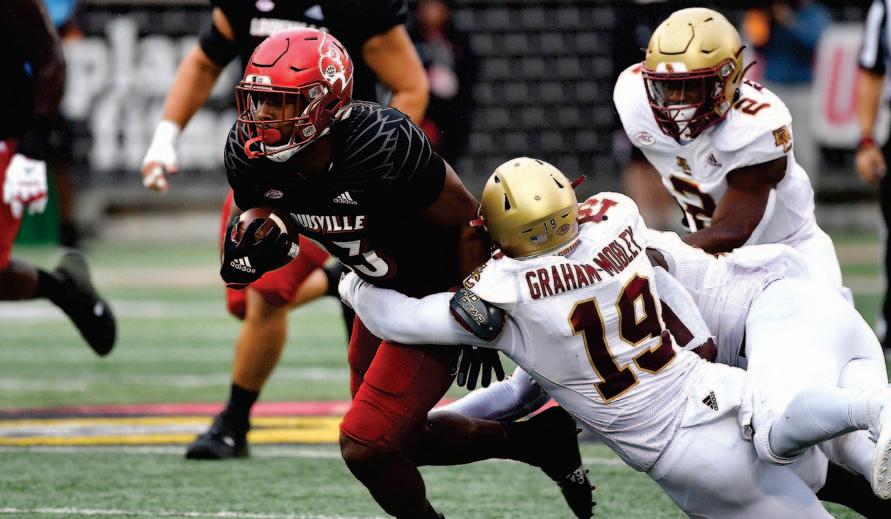
With Cunningham’s success came Grosel’s breakdown and that of the entire BC offense. At the end of the first half, the Eagles boasted a total of 105 yards on offense with 65 coming through the air and 40 on the ground. After his perfect 4-for-4 start, Grosel was rendered completely ineffective, completing four of his next 12 passes.
“Execution needs to be on a higher level at all times,” Grosel said. “Third down really tells the story here. We couldn’t keep the chains moving, couldn’t stay in rhythm. … When we start off in rhythm and get out of it, it’s tough for us to fight back and get in there. That starts with conversions, it starts with execution, and it starts with
first downs.”

Despite BC’s failure to move the ball, its halftime deficit was just 14 points. Defensively, three turnovers ended Louisville drives short of the endzone. BC recorded a fumble in the first quarter, then Brandon Sebastian and Jaiden Woodbey followed with interceptions of their own. The turnovers did not result in points, however, as the Eagles remained unable to push downfield.
“When you steal possession, it’s not just about stealing possession— you’ve got to score points,” Hafley said. “It wasn’t just off of the takeaways. We were pretty inefficient at that for most of the night.”
Aside from its collection of turnovers, the BC defense struggled to stop Louisville on the ground throughout the game. Ultimately, the Cardinals managed 331 yards on the ground, with Cunningham recording 133 himself. All four of Louisville’s touchdowns also came via the ground, with Cunningham trotting into the endzone three times on the night.

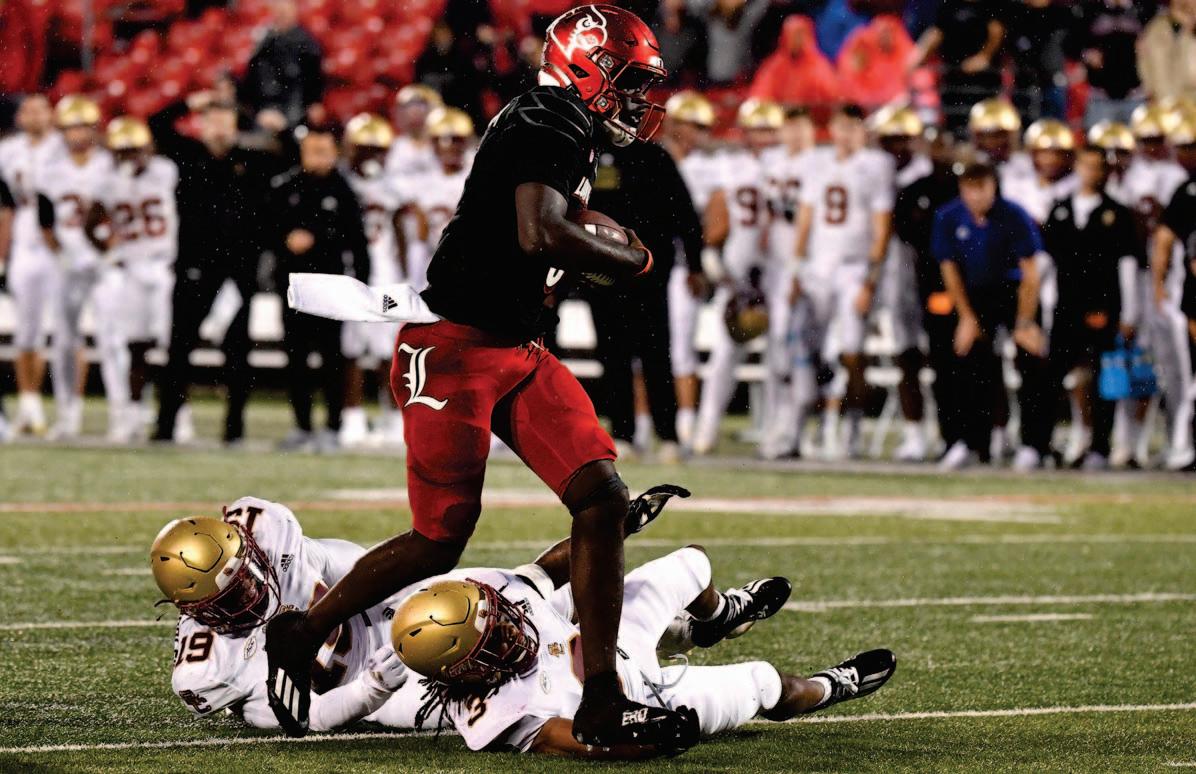
Hafley’s halftime adjustments could not provide any steam for the struggling BC offense, but they did reinvigorate its defense. Louisville’s only chance to score in the third quarter was a missed field goal, and the score remained 21–7 at the start of the fourth.
“We did a really good job in the second half,” Hafley said. “They came out with a different run plan than we’d seen on tape, and we figured it out pretty quickly. … Until that last drive I don’t know how much success [Cunningham] really had.”
Down by two scores, the BC offense showed some life as the game wound down. After a quiet first three quarters, Pat Garwo III took charge of BC’s offense, pushing the Eagles downfield with run after run. BC survived a 3rd-and-1 offsides call with a conversion on 4th-and-5, and suddenly the Eagles were within scoring range with 11:15 on the clock. Moments later, Grosel connected with Trae Barry on third down to set up first and goal.
With nine yards between BC
Read the rest of this story at www.bcheights.com




A lot can change in a month. On Sept. 25, Boston College football fans stormed the field as BC moved to 4–0 with a dramatic overtime win over Missouri and seemed on track to mount a successful ACC campaign despite the loss of Phil Jurkovec. A loss to Clemson was sloppy yet still spoke to the Eagles’ potential, but the wheels have fully fallen off over the past two weeks. BC looked unprepared on both sides of the ball to face NC State, and it was more of the same against Louisville on Saturday. The Cardinals racked up 331 yards on the ground, and head coach Jeff Hafley was forced to admit postgame that his staff may have to evaluate other options at quarterback. The Eagles dropped their third straight game for the first time since 2018 by a final score of 28–14. Here are three takeaways from the game:
The Eagles’ defense appeared unprepared to handle the Cardinals’ speed from the get-go, and though it performed slightly better in the second half against a dynamic offense, the

low-scoring total mainly came from good turnover fortune, as BC held Louisville to just one touchdown in the second half. BC was outclassed in both scheme and talent, as Malik Cunningham and Louisville’s speedy backs ran circles around the defensive line and gashed through the secondary.
BC is far from the first team that Cunningham has run all over during his career, but the dominance of backs Jalen Mitchell and Trevion Cooley made Cunningham look even better—and made BC’s defense look even worse. Playing against what is usually a generous Virginia defense last week, neither back managed to record over 3.5 yards per carry. Even in the duo’s best game of the year against Wake Forest, they did not manage to get close to the play that they flexed against the BC.

Louisville boasts a strong offense on the whole, but the Eagles’ lackluster performance made Louisville’s run game look much like it did with famed dual-threat quarterback Lamar Jackson. The Eagles’ defensive line got no push, the linebackers showed they did not have the speed to get to the edge, and BC’s safeties missed vital tackles left and right, giving up
explosive plays.
Offensive Line Still Waiting to Match Potential in Year Four
After a couple of weeks filled with uneven pass blocking, constant false start penalties, and poor snaps, BC’s offensive line needed a big week against a weak Louisville defense to reset its supposed status as one of the best units in the ACC. It quickly became clear, however, that BC’s experienced offensive line had not lived up to its potential once again.
Just two minutes into the game, Louisville linebacker Yasir Abdullah blew untouched past Tyler Vrabel and brought down quarterback Dennis Grosel with a crushing hit to force the Eagles into punt formation. In the same quarter, one of Alec Lindstrom’s snaps nearly sailed over Grosel’s head, eerily reminiscent of the multiple faulty snaps that cost BC the game against Clemson.
The offensive line did a solid job in the run game and created some huge holes, but the pass blocking struggles that the Eagles showed early continued
Read the rest of this story at www.bcheights.com
With a double-digit loss to Louisville, the Eagles are on a three-game losing streak for the first time in Jeff Hafley’s tenure.Louisville quarterback Malik Cunningham ran for 133 yards on the ground. After early-season success, the Eagles have struggled in conference play, going 0–3 through their first three ACC games .
An impressive four goals in the first period for Boston College women’s hockey was nearly all that it needed to secure a 5–2 win against Maine (2–7–0, 0–4–0) on Saturday afternoon. The No. 4 Eagles remain undefeated through their first six games this season for the third time in program history.

Junior Hannah Bilka and freshman Abby Newhook, two leading point scorers for the Eagles (6–0–0, 4–0–0 Hockey East), swiftly broke through the Black Bears’ defense in the fifth minute to kick off the four-goal opening period. Bilka skillfully split the defense on a toe drag, allowing Newhook to score her fourth goal of the season to build an early lead.
Assisted by Newhook and Willow Corson, Bilka followed up her assist with a goal of her own as her breakaway shot from the circle deflected just three minutes later. The Eagles continued their offensive attack in the 15th minute
of the matchup, as sophomore Gaby Roy scored a backhand off a clearance pass from Jillian Fey for a short-handed goal. Two minutes later, Caroline Goffredo scored when her wrist shot trickled past the goal line after a save by goaltender Jorden Mattison, bringing the Eagles to an assertive 4–0 lead.
The Black Bears came out stronger in the second period, putting more shots on net and generating scoring opportunities. After pulling their netminder Mattison, who stopped nine of 13 shots faced for a 0.692 save percentage, the Eagles failed to score against replacement goaltender Loryn Porter on any of their eight shots against her.
A little over halfway through the second period, Maine’s Morgan Trimper scored after the puck landed in front of her after a poke check by goaltender Abigail Levy.
In the early minutes of the third period, Ally Johnson tipped in a rebound on a power play for her fourth goal of the season to bring the Black Bears within two.
Despite their efforts, the two goals
were not enough to overcome the deficit and Levy’s impenetrable wall.
Levy recorded a 0.946 save percentage, stopping 35 shots in total. She continued to prove why she ranks first in the nation among goaltenders, especially when she kicked out her left pad while sprawled out on the ice to prevent a goal in the first period.
The Eagles regained the momentum following Maine’s power-play goal in the ninth minute of the third period, when Bilka scored her second goal of the game on a breakaway after intercepting a pass.
Although the Eagles proved their dominance on the ice with 30 faceoff wins and 14 blocked shots, their aggression also translated to penalties. Three
tripping calls and one cross-checking call led to four power plays for the Black Bears, while the Eagles did not gain any power-play opportunities. Despite this disadvantage, and Maine outshooting BC 59–53, nine Eagles, including Levy, recorded a point and the Eagles emerged victorious for the sixth time this season.
Whether it was the roaring Senior Night crowd or the energy exuding from the floodlights, something was in the air for Boston College men’s soccer on Saturday.
The Eagles (6–5–2, 2–3–2 Atlantic Coast) pulled away with a 3–2 win over Wake Forest (9–5–1, 3–3–1) on Saturday, upsetting the Demon Deacons in a Senior Night ACC thriller.
The energy was high from the beginning of the match, with BC and Wake Forest each having their fair share of ball control. It wasn’t until the 27th minute, though, that the momentum really began for the Eagles.
A throw-in from Adama Kaba landed at the feet of junior Michael Suski, who took matters into his own hands, pushing past Wake Forest defenders before launching one past the hands of goalten-
der Trace Alphin and into the top right corner of the net.
Up by one, BC’s momentum continued to grow throughout the remainder of the half. The Eagles displayed a brick-wall defense led by big stops from junior Victor Souza and graduate student Wil Jacques.
Seventeen minutes after Suski’s rocket, the Eagles had another opportunity to get on the board. Junior Stefan Sigurdarson was tripped in the box and stepped up for a penalty kick. Sigurdarson slid his shot into the bottom left corner of the box, setting up BC with a 2–0 lead to enter the second half.
Suski and Sigurdarson’s offensive dominance comes as no surprise, as the two have combined for 12 of BC’s 15 goals on the season—six apiece.
Though BC’s energy was high entering the second half, Wake Forest was out for vengeance.
The Eagles had multiple early chances, including one in just the first 30 seconds of the half, but could not capitalize on them.
With 33:13 left to go in the game,
Wake Forest seemed to be presented with the perfect opportunity to get itself on the board. As BC goaltender Brennan Klein scrambled to get back into net after getting involved in some action out of the box, Jahlane Forbes sent a cross right in front of an essentially open net. The Demon Deacons did not get a good touch on it though, as the ball was sent sailing over the crossbar, maintaining BC’s two-goal lead.
Wake Forest eventually capitalized on an opportunity in the 63rd minute. Barely keeping it in bounds, Roald Mitchell snuck the ball across the goal line, as Kyle Holcomb slid in toward the net, knocking Mitchell’s pass right into the goal.
It didn’t take long for BC to answer, though. Just two minutes later, freshman Aidan Farwell carried the ball up the sideline before notching it to Suski. Suski showed off his footwork, dribbling in and releasing the ball at the last second, sliding his second goal of the night into the bottom left corner of the Wake Forest’s net—and bringing BC’s lead back
up to two.
From there, it was catchup for the Demon Deacons, who outshot the Eagles 6–2 for the rest of the half. Though both teams took three shots each in the first half, Wake Forest outshot the Eagles for the rest of duration, taking seven shots to BC’s four in the second half.
But it came down to shots scored, not taken, and despite a successful Wake Forest penalty kick with just under four minutes to go, the Eagles defense continued to make clutch stops as time expired and BC was able to hold onto its narrow lead.
BC’s upset over Wake marks its second consecutive ACC win heading into the Eagles’ final regular season game against NC State.
“We had a big win last weekend against Syracuse, and now we have two in a row against Wake Forest as well,” Klein said after the game. “They’re big ACC games so you know, we can only go up from here and we’re excited about it, and everybody’s happy right now, team morale’s up, so we’re looking good.”
BY NICK PULICE Heights StaffAfter its dominant victory over then-No. 18 Northeastern in last Friday night’s home opener, it seemed that Boston College men’s hockey was back on its way to yet another dominant regular season. But the team had struggled to regain its form from that night, dropping its next two games to unranked opponents.
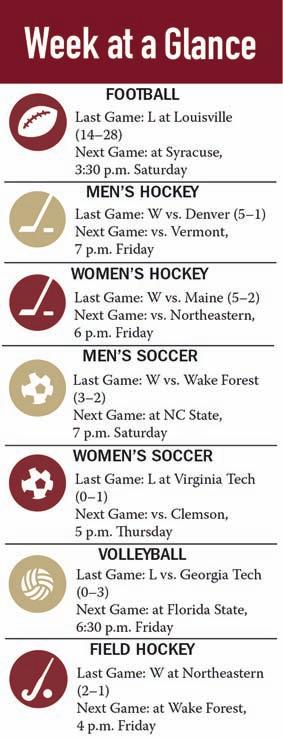
In their second game against a ranked team this season, the Eagles finally looked like that team from the home opener once again. The No. 10 Eagles (3–2–1, 1–0) played a near-perfect game from beginning to end en route to a 5–1 victory over No. 8 Denver (4–2) on home ice at Kelley Rink.
Though the first frame passed
without a score, both sides had their chances to break the ice. Denver went on a power play in the first two minutes of the game following a hooking call against Patrick Giles. The Pioneers were peppering Eagles’ netminder Eric Dop from close range, but Dop stood tall in the crease to hold Denver scoreless despite some strong power-play opportunities.
With about seven minutes remaining in the period, the Eagles were inches away from a 1–0 lead.
In search of his first goal as an Eagle, Sam Sternschein’s shot from the right circle rang off the pipe.
As Conte Forum filled up with more students during the intermission, the Eagles on the ice stepped up their game in the second period of play. BC got on the board just four minutes into the frame. Drew Helleson wristed a shot from the blue line that was deflected by a Colorado defenseman. Off the deflection, the
puck floated up and over the shoulder of Denver goalie Matt Davis, who was screened on the play, to put the Eagles up by one goal. The goal marked the first goal of the season for the talented junior defenseman.
Following Helleson’s goal, Denver generated some chances of its own, but once again, Dop stood tall along with the help of the crossbar. With 26 saves on the night, the Bowling Green transfer has begun to find his footing.
In the final minutes of the period, the Eagles doubled their lead. Marc McLaughlin stole the puck and took it down the ice on a breakaway. He was tripped up but still managed to set up Colby Ambrosio on the doorstep, but Davis robbed Ambrosio on his initial attempt.
The puck remained loose before it found Ambrosio yet again. This time, he kicked the puck over to Trevor Kuntar, who fired a slap shot
to beat Davis for the well-deserved goal. Kuntar’s first goal of the season would be the final scoring play of the second period.
The Pioneers came out of the intermission flying and were quickly rewarded for it. Brett Stapley took a shot from the slot that found its way through the net-front traffic and past Dop to cut BC’s lead in half.
After giving up a third-period lead against Colorado College one night prior, the Eagles scored a crucial insurance goal while on the power play. Helleson’s shot from the blue line was deflected into the net by Jack McBain. Davis made the initial save, but McBain was able to bat the rebound out of midair and into the goal to give the Eagles a two-goal advantage, sending the Conte Forum crowd into a frenzy.
“Last night, I thought we were very loose,” BC head coach Jerry York said in his postgame press confer-
ence. “There was just more composure tonight. The game was 2–0 in the third and it gets to 2–1, and we still stayed strong throughout the period.”
The Eagles truly put this game away in the final three minutes. First, it was Marshall Warren’s empty-net goal from the complete opposite end of the ice that made it 4–1. Just 46 seconds later, Nikita Nesterenko wristed a shot off the left shoulder of Davis and into the net to make this a 5–1 game, which held to the final buzzer.
Even though it has been a rocky start to this season, the Eagles showed once again that they can compete with any other team in the country.
“Denver, in my opinion, are the best team we played up to this point,” York said. “It seemed to give us a lot of energy in our game. We were better structurally tonight.”
Boston College women’s soccer won its first two games of the season by a score of 1–0. As the season comes to a close, BC has fallen into a similar script, this time falling on the wrong side of shutouts. The Eagles played their sixth single-goal game of the season Sunday afternoon, falling to Virginia Tech without ever finding the back of the net.
The Eagles (7–8–1, 1–8–0 Atlantic Coast) came out kicking in the first half, with five shots on goal. Virginia Tech (9–5–2, 4–3–2), meanwhile, recorded just two shots on goal in the first half, and the Hokies’ lone goal of the game came with 20 minutes elapsed in the first half. The Hokies held down the second half, escaping with a 1–0 win at home.
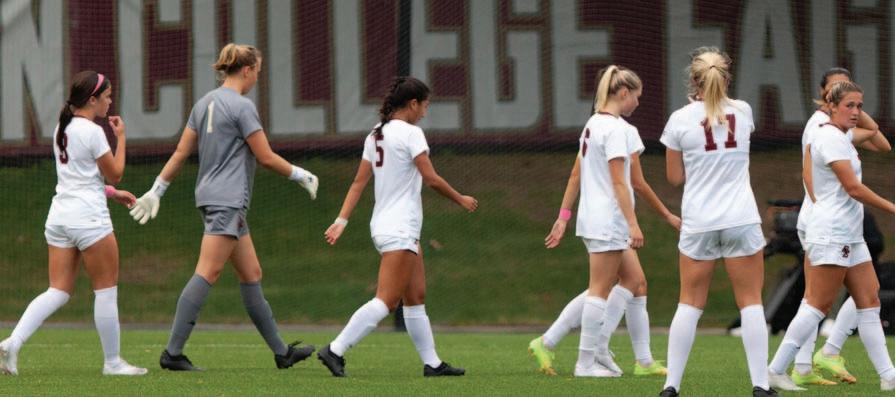
After a quiet start to the game, Virginia Tech forward Allie George broke free on the right side of the field. She kicked the ball out past a sliding BC defender to mid-
fielder Emma Pelkowski, who redirected the pass toward the net. BC goaltender Wiebke Willebrandt lept out to block the shot, but she was too late. Pelkowski ran into her teammates’ embrace after having decided the game’s fate with a single shot.
Although it failed to tally any points, BC was the better team through the first half. The first-half stat sheet was unbalanced in BC’s favor, with the Eagles applying far stronger pressure than their opponents. When the two teams took the field after halftime, however, Virginia Tech flipped the script.
The Hokies managed six shots on goal in the second half, three times more than their first half total. BC, on the other hand, had almost no chance of scoring the tying goal. Almost halfway into the second half, Ella Richards took BC’s only shot on the Virginia Tech goal of the half.
Hokie goaltender Alia Skinner was ready and came up with the save, killing BC’s final chance at leveling the score.
The Eagles were also plagued by fouls in the second half, committing nine violations after just three in the first.
Despite BC’s offensive breakdown in the latter part of the game, Willebrandt kept it close. She saved seven shots throughout the game while allowing just one to find the net. In her freshman season this year, Willebrandt has allowed an average of just 1.73 goals per game. She has saved a total of 82 shots in 17 games, providing a reliable backstop for
the Eagles.
With a freshman shoring up BC’s end on defense, the Eagles looked to their experienced players for offense on Sunday. Jenna Bike, Samantha Agresti, Richards, and Abby McNamara each took two shots on the afternoon, while three other Eagles tried to get in on the scoring with shots of their own.
With eight goals on the season, Richards is currently tied as BC’s leading scorer. Bike is close behind with four goals of her own in a tie for the second most on the team.
Read the rest of this story at www.bcheights.com
Boston College field hockey defender

Sky Caron has long since proved herself as one of the most capable members of BC’s defensive corps. The 5-foot-8 senior is all power, and she continually showcases her strength with swooping aerial passes and key defensive stops.
Caron has also been BC head coach

Kelly Doton’s go-to option for penalty stroke opportunities for her four years on the Heights—and for good reason. Of the 11 attempts Caron has taken over the course of her career, she’s netted goals on nine of them. In the third quarter of the Eagles’ matchup with Northeastern, BC was awarded a penalty stroke. The Eagles were sporting a tenuous one-goal lead and were in desperate need of an insurance goal to give them some breathing room.
Caron got the nod to take the shot, and the veteran blasted a shot past Northeastern goaltender Erin Savage, netting
the eventual game winner for the Eagles.
Though Northeastern (5–11) responded with a third quarter goal of its own, No. 13 BC (10–5) held onto its lead and earned a 2–1 win over the Huskies.
This season, BC has displayed a knack for keeping spectators and fans on their toes. Of the Eagles’ 10 wins this season, seven of those ended with BC up by just one goal.
A strong start was key to BC’s success against Northeastern. The Eagles wasted no time in the first quarter and began testing Savage early on. Five different Ea-
gles combined for seven shots in the first quarter, which set the tone for a strong offensive showing from BC.
Graduate student Elizabeth Warner kicked off the scoring less than two minutes into the game. On a penalty corner, Caron’s shot was blocked, and the ensuing rebound popped out to Warner. She coolly placed the ball past Savage, granting the Eagles a one-goal lead that would last through the first half.
Neither team recorded a single shot through the second quarter. Aside from a BC penalty corner at the beginning of the frame, most of the action took place between the 25-yard lines. BC’s capable midfield, composed of veteran Fusine Govaert as well as Juliette Hijdra and Kendall Hanlon, shined in the back-andforth affair.
Despite Caron’s goal just 30 seconds into the third quarter, Northeastern came out with renewed energy in the second half. The Huskies earned three corners and outshot the Eagles 5–3 in the third frame. Their efforts were rewarded when offensive catalyst Mak Graves snuck a shot past BC goaltender Jonna Kennedy with three minutes left in the quarter, earning her seventh goal of the season.
Graves’ shot was one of just two
shots on goal all game against Kennedy.
BC continued to sustain offensive pressure on the Huskies through the fourth quarter, but the Eagles could not put another shot past Savage, who made four saves in the frame. She finished with 11 saves on 13 shots on goal.
Caron and Kennedy, a dynamic defensive duo on the Eagles’ squad, will take their talents to South Africa this December. Earlier this week, they were named to the United States’ 18-woman roster for the Junior World Cup. The pair, along with Nell Webber, was honored in BC’s Senior Night on Friday, in which the seniors picked up a key ACC victory over Duke.
BC is riding a two-game win streak into its final regular season game. The Eagles will travel down to Winston-Salem for a Friday matchup against Wake Forest, their final test of the season before the ACC tournament. Despite their winning record, BC has struggled against ACC opponents this season, recording close losses to Syracuse and Louisville and falling big against UNC.
The ACC is home to three of the nation’s top 25 Division I women’s volleyball programs, and with that talent comes competitive game after competitive game for Boston College volleyball.

The Eagles have overcome a challenging schedule and currently sit 23rd in the country in both team kills and team assists. BC (13–10, 3–6 Atlantic Coast) has also strung together three conference wins so far this season, most recently with a 3–1 win over Clemson (11–9, 3–6).
The match was close throughout, and
Clemson put up a fight in the first three sets. BC took the first set 25–23 before Clemson evened the match with a 25–20 win in the second. The Eagles retook a oneset lead in the third with a 25–20 set win.
Statistically, the teams could hardly have been more evenly matched, but BC stood out in a few key categories to emerge victorious. The Eagles outhit Clemson .274 to .235. BC also more than doubled the Tigers’ ace total, 13–6. The only category in which Clemson bested the Eagles was blocks, which the Tigers led 8–6.
As for individual performances, Mckenna Slavik shined for the Tigers’ offense. She controlled the game for the Tigers, racking up 46 of their 48 assists. Grace Penn led the passing for the Eagles,
assisting on 28 points. Clare Naughton, Amaka Chukwujekwu, and Izzy Clavenna all recorded over 10 kills for the Eagles.
The Eagles soared away in the fourth set, winning it 25–17 and out-hitting the Tigers .29 to .077. The fourth set was crucial for BC, as Clemson has yet to lose a game that has gone to five sets so far this year.
BC’s win on Friday puts both the Eagles and the Tigers into a four-way tie for ninth place in the conference. The Eagles are now one win away from matching their conference win total from last season.
The win was crucial for the Eagles, as it snapped their five-game losing streak, during which they lost 15 of the 18 sets they played.
opinions and commentaries of the op-ed columnists appearing on this page represent the views of the authors of those particular pieces, and not necessarily the views of The Heights

I’ve heard many adults refer to vaping and juuling as the “epidemic of our generation”—a title that has lost its bite in the past year due to the actual pandemic. But the sentiment remains as campaigns across the country continue to crack down on vape usage.
Boston College followed suit by updating its smoking policy as of Aug. 1, 2020 to include vaping on its list of prohibited activities, therefore making it punishable to vape on campus. The University recognizes not only the health risks associated with the carcinogens and toxic chemicals in vapes but also the difficulty associated with quitting, and hopes that students take advantage of the resources necessary to quit.
Regardless of the University’s policy, however, vaping persists. In my personal experience, there has been at least one person with some type of vape at every social gathering I’ve been to, without exception.
I think it is safe to say, at this point, we are all pretty aware of the health effects of vaping. Without getting into minutiae, we know that vaping is just not good for us. And generally, if we know the chemicals in vapes are not good for our own health, then by extension those chemicals cannot be good for the health of plants, animals, micro-organisms, etc. Whether we intend it or not, the chemicals in vaping devices eventually end up interacting with the natural world when we throw them away. The entire industry of vaping is environmentally unfriendly—from manufacturing all the way to disposal.


So, let’s begin with the manufacturing process. As with any product, creating a vape requires a combination of energy and materials. Metals and heavy metals need to be obtained for the battery. The nicotine in vapes is often synthetic, created using solvents like formaldehyde, formic acid, and dichloromethane in multiple rounds of purification, and therefore a resulting multiple rounds of waste are emitted into the atmosphere. Unfortunately, emissions from these manufacturing plants are typically not measured because the Environmental Protection Agency doesn’t require plants that do not meet the Toxics Release Inventory to submit reports on their emissions, so we do not even have the full picture of what these emissions look like.
Then there is the process of actually vaping, which is mostly only harmful for the person using the vape, but it never hurts to hear it again. Over 70 percent of what’s inhaled from a vape is eventually exhaled, which poses a problem for indoor spaces because pollutants are not diluted as well as they are in outdoor spaces. Therefore, indoor concentrations of particulate matter from vaping can potentially reach up to 45 times as high as the World Health Organization’s limit for outdoor concentrations.
And finally, there is the problem of what happens to the vaping device after it’s been used. In general, vaping creates a lot of both toxic and plastic waste. Once thrown away, the vape can leak the aforementioned heavy metals, battery acid, and nicotine into the soil and groundwater, eventually making its way into the lives and bodies of animals and plants. The biggest blight of vapes—from an environmental perspective, that is—is that most of them are single-use or disposable, like Juuls and Puff Bars. And because they are most often plastic, their waste will not biodegrade at all. This means that if the founders of BC in 1863 took a hit of a vape and left it on Stokes Lawn (and what an image that is), the trac-
es of plastic and chemicals would still be there. The vape device will eventually deteriorate into the microplastics and chemicals that comprise it, which will make their way out into waterways to pollute them and surrounding wildlife.
This less-explored route of vaping’s environmental effects is not to undermine the campaign against them for the sake of human health, as vaping impacts the people using them the most and I hope that all who need help quitting get the assistance they need.
That being said, I think it is important to shed light on vaping’s environmental effect because it is often overlooked. I think the disposal of the single-use vape products is particularly overlooked because the subject of vaping is almost boorish—people don’t really casually talk about vaping, much less how to dispose of vapes. Plenty of people who have vapes are underage, and therefore are much more worried about being caught with a vape than how to properly dispose of it.


The fault of not properly disposing of vapes does not all fall on the consumer, though. Vape manufacturers do not give any guidance on how to throw away their product or take accountability for their own waste. Studies show that youth vape users understand that vape waste is bad for the environment, but do not know how to properly dispose of vapes because of the lack of information available. To that end, Green Smoke and Call2Recycle are two companies looking to mitigate the problem of vape waste by offering disposal solutions, and there is more information on disposal available online as well.
At the end of the day, personal choices are personal choices. So, no matter what your personal choice is, I would implore you to consider the environmental consequences of vaping.
Last weekend, campus was brimming with the same excitement that floated in the air on Family Weekend. Reunion Weekend tapped into the unity and camaraderie that hold the Boston College community together. Even sweeter was being able to see Class of 2020 graduates finally get the graduation pictures, champagne, and commencement speech they deserved.
The TI-84 Plus is the holy grail of all calculators and an ode to the original abacus. Through thick and thin, this calculator will stand by your side. It can survive any and all conditions, even the bottom of a middle schooler’s backpack, and should be passed down as a family heirloom.
tion.
Boston College campus tour guides often have to bend the truth. In some cases, they might even snap it in half. Perhaps the biggest lie any BC tour guide provides to their unsuspecting group of high school seniors is about Newton Campus.
“Newton isn’t all bad. In fact, I know so many people who found their closest friends there!”
“If you’re on Newton, you’ll meet so many cool people on the bus!”
“The Newton bus only takes about 10 minutes, and it actually gives you a nice home away from campus. It’s really unique!”
It’s not original to dramatically complain about Newton Campus. Being a Newtonian myself, I’m more than a little sick of hearing about post-housing satisfaction surveys and the many endearing nicknames for Duchesne Hall.
This year, though, concerns from the Newton freshmen at BC appear to be more justified than in years prior. As a national labor shortage threatens bus transportation across the United States, BC’s bus system has been especially unreliable. This year’s bus schedule is reduced compared to years prior, which is due to a shortage of staff. Many of my peers and I have seen the bus system change from a slight inconvenience to a genuine frustra-
Labor issues in 2021 are not unique to BC. The national labor shortage has affected a wide variety of jobs in Massachusetts, including many on BC’s campus. Aside from bus drivers, this is most visible within the dining halls. Reminders to “try something new” are pasted along the walls of Lower, alongside an apology for any limits to service. The Chocolate Bar has also been experiencing labor shortages, and has had to close multiple times so far this semester. This labor shortage originated from the mass layoffs early in the pandemic and exists partly due to a disturbing disparity. Even as the economy is reopening, companies are struggling to make entry-level salaries attractive to potential employees. Now that this labor shortage has caused many to reconsider their definition of fair compensation, we should examine how this may apply to the bus drivers at BC.
BC Transportation outsources its bus drivers from the large, private bus system BostonCoach for the Newton and Commonwealth Ave. lines of transit. According to ZipRecruiter, these kinds of charter bus drivers in the Boston area make between $36,189 and $50,773 per year. Meanwhile, new listings for single-person Newton apartments at their least expensive are at around $1,800 per month. It’s not hard to do the math—making the generous assumption that BostonCoach pays drivers in the higher end of this salary range and that the least expensive apartments in Newton would be available to these drivers, a BC bus driver would still be spending over 40 percent of their income on rent just to live nearby. This is significantly higher than the recommended maximum of 30 percent of
one’s income being used for rent, and it is a clear sign of underpayment relative to labor.
The underpayment and subsequent shortage of bus drivers is bad for BC students as well. Fewer bus drivers has led to missed stops and extended wait times for hundreds of undergraduates at BC waiting for both the Newton and Commonwealth Ave. lines of transit. This undoubtedly impedes the academic experience at BC. Speaking from personal experience, it is difficult to plan out a weekend of studying between Main Campus and Newton when buses are so unreliable.
So, what’s the solution? Increasing the base salary of bus drivers, especially those at BC, is a clear remedy to improve drivers’ standard of living, reduce the wasted time of the BC undergraduate population, and curb the labor shortage in the Newton area. After all, according to a study by BTIG, higher pay is the primary motivator by the unemployed to return to an hourly wage position.

Unfortunately, due to the existing contract for shuttle services between BostonCoach and BC Transportation, the University is not in control of, nor even privy to, the salaries of bus drivers. Solving the issue of bus driver salaries would require significant effort by the administration to find a contractor willing to pay a livable wage to its employees, and could take months of work. Still, solving the bus problem at BC should not be a daydream of Newton kids—it’s the appropriate response to the economic environment surrounding BC.
Tommy Roche is an op-ed columnist for The Heights. He can be reached at thomas.roche@bc.edu.


Still embarrassed from your laptop overheating last week? That’s okay. Sometimes nothing beats good ol’ fashioned pen and paper. That is, until it comes time to print. Coercing the select few printers on campus to cooperate is like trying to befriend a squirrel. They’re evasive, they’re crafty, and they can smell a midterm deadline coming from a mile away (just in time to run low on ink).
In opposite proportion to the number of printers on campus is the number of slow walkers. Hitting the Quad during rush hour is a grave mistake. Worst of all, the traffic is not mainly the result of large groups spreading out across the path, but instead a slew of particularly slow individuals who chose to wake up each morning without any amount of hustle whatsoever.